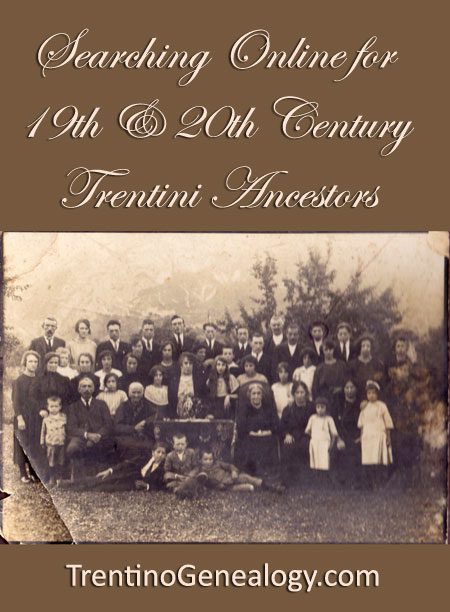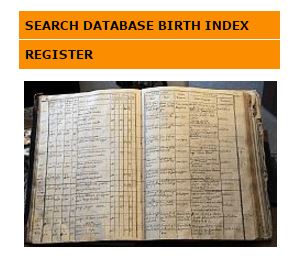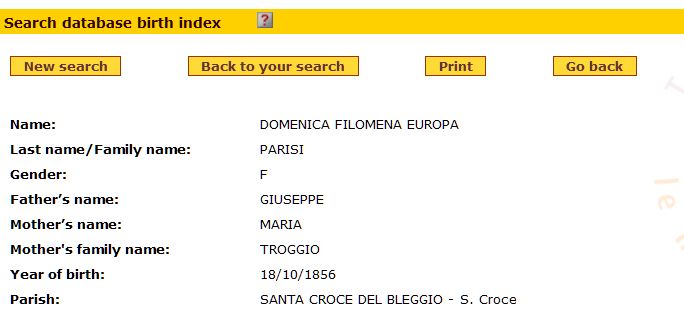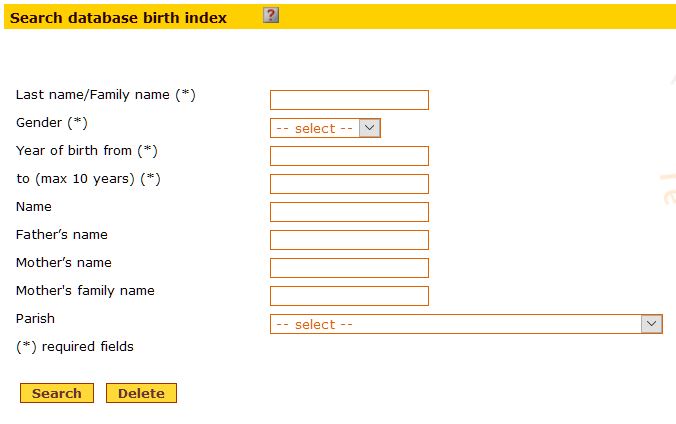PLEASE NOTE: This is an older article (2016), and much of the information in it is no longer accurate. To find out about the NEW Nati in Trentino website and how to use it, I refer you instead to my VIDEO TUTORIAL on YouTube:

Genealogist Lynn Serafinn explains how to find your ancestors using use ‘Nati in Trentino’, a free online database of baptisms from the Archdiocese of Trento.
UPDATE MARCH 2021: Since publishing this article in 2016. the Nati in Trentino website has been UPDATED. You will find the new website at by clicking here: Nati in Trentino (1815 – 1923) (mondotrentino.net).
While most of the information in this article is still relevant, some of it is now out of date. I have created two video tutorial on how to use the NEW website, which you will find on my ‘tutorials’ here:
ORGINAL ARTICLE FROM 2016:
Last time on Trentino Genealogy, we started our discussion on parish records. In that article I spoke about what we can learn from church records, and the role of the parish in Trentini life. I also mentioned that there were three primary ways to access parish records from the archdiocese of Trento:
- The Nati in Trentino website
- Microfilms made by the Latter Day Saints (LDS)
- The archives of the Archdiocese of Trento, in Trento, Italy
If you didn’t catch that article, you can read it by clicking HERE.
In today’s article, I’m going to be talking about the Nati in Trentino website, because I believe it is especially helpful for anyone who is just starting to construct their Trentini family tree. It is also highly useful for experienced researchers who quickly want to flesh out parts of the 19th and early 20th century in their tree.
In this article, I’ll be looking at:
- What Nati in Trentino is and how to access it
- Advantages of using it for research
- What the site CAN and CANNOT tell you (compared to the original parish records)
- Technical limitations of the site
- Tips and tricks for getting the most out of it
Nati in Trentino – What it is and how to access it
Nati in Trentino is a free, searchable website located at https://secure.natitrentino.mondotrentino.net. This site contains a database of information taken from ALL baptismal records registered in the Archdiocese of Trento between the years of 1815 and 1923. The project was done by experienced researchers at the Archivio dell’Arcidiocese (the archives of the archdiocese).
When you land on the site, select your preferred language. Assuming you’ve selected ‘English’, after you enter the site, look to the right side of your screen and you will see these options:
 Click on the image to see it larger.
Click on the image to see it larger.
If you click “Search Database Birth Index”, it will take you to a log-in page. If you already have an account, you can log-in here. If you haven’t yet created your free account, you register from that page as well.
NOTE to Users of Ancestry.com and similar sites: The Nati in Trentino database is owned by the Archdiocese of Trento, and is NOT accessible via other, commercial sites. The only way to access it is to go directly to the Nati in Trentino website.
Advantages of Using Nati in Trentino
It has been made by EXPERTS
I think this is the primary advantage of using Nati in Trentino. The people who made this database are not random volunteers (as is the case with MANY other online databases) but official researchers who work for the diocese. They are native Trentini who speak Italian AND have studied Latin. They are familiar with the parishes and local surnames of the region. They have been trained to read old handwriting. Furthermore, these people (and I know some of them personally) CARE about preserving this history.
It is extremely accurate
Unlike so many other transcription projects you might find on the Internet, Nati in Trentino is clear and accurate. You’ll especially appreciate this if you’ve ever found yourself pulling your hair out trying to make sense of your Trentini ancestors’ names and villages in US census records or Ellis Island documents.
It has an English language option
If you are an English speaker, you will especially appreciate the Nati in Trentino website as you don’t need to have any knowledge of Italian to use it. Also, if you are less experienced in working with parish records, it takes the guesswork out of trying to read the priests’ handwriting.
It can save you time
Lastly, the most obvious advantage is that it can save you hours of research time. Records that might otherwise take you hours to find via microfilm can often be found within minutes. For speed and ease of use, there really is no other Trentino resource like it (not yet, anyway!). I often use the site to do a ‘first draft’ of certain family groups for the 19th Century. Then, when I next have an opportunity to work directly with the images of the baptismal, marriage and death records, I can start to fill in the missing information.
Article continues below…
What The Site CAN and CANNOT Tell You
It is important to be aware of what the site can and cannot tell you, lest you inadvertently assume the wrong person is your ancestor. One thing to bear in mind is that this site does NOT contain the full transcription of the baptismal records. Nor does it contain the images of them. Thus, many things that are probably IN the baptismal record are NOT included in the search results on Nati in Trentino.
To give you an idea of how a search on Nati in Trentino differs from an original parish record, compare these two images. First, is a screenshot of a search I did on Nati in Trentino for my great-grandmother, Domenica Filomena Europa Parisi (who was known in life only as ‘Europa’):
 Click on the image to see it larger.
Click on the image to see it larger.
As you can see, from this record we now know:
- Europa’s full name
- Her gender
- Her date of birth
- Her father’s first name
- Her mother’s first name
- Her mother’s maiden surname
- Her parish
VERY IMPORTANT (especially for readers in America): European dates are written with the DAY first, followed by the MONTH (the opposite of what is used in the United States). If you see a date that says 06/12/1850, for example, it means December 6th, NOT June 12th.
About the date of birth
Prior to the introduction of printed forms (about 1810), parish records would only record the date of baptism, rather than the date of birth. For this reason, most researchers will use the baptismal date as a date of birth in a family tree, if no other record of birth is available. In earlier times, due to the high mortality rate, a child was often baptised within hours of their birth anyway (sometimes by the midwife). But by the 19th Century, there might be a gap of one or two days between the birth and baptism of a child; both of these dates are recorded in most Trentino parish records from about 1810 onwards. Wherever both dates have been recorded, Nati in Trentino will give you the actual date of birth.
About parishes
You don’t need to know the parish from which your ancestors came to search the database, but it can really help narrow down your search, especially if the surname is common to several areas of the Province. Fortunately, the search function includes a drop-down menu of all the parishes (which means you don’t need to know how to spell them!).
You can find a complete list of parishes in the Diocese of Trento on Wikipedia. They are grouped into their respective valleys. I don’t know how accurate this list is, as it isn’t an official site for the diocese, but I cannot find a live link on the dioceses site anymore.
Now let’s compare the information we found out on Nati in Trentino to the information you will find in the original parish record. Europa’s entry is the last one in the image:
 Click on the image to see it larger.
Click on the image to see it larger.
If you look closely at this image, you will see that, in addition to the information you found on the Nati in Trentino website, you now also know:
- Europa came from the frazione of Duvredo (written in the left margin).
- She was born at 10 PM
- She was baptised the day after she was born.
- The midwife who delivered her was Margarita Furlini (written under Europa’s name). In fact, if you look closely, you will see that Margarita delivered ALL the babies on this record (that’s four babies in within 20 days).
- Europa died on 24 Feb 1937 (this was inserted by the parish priest many years later)
- She was Catholic
- She was the 44th girl baby to be born in the parish that year
- She was legitimate (i.e. her parents were married)
- The names of all four of her grandparents (full names of the grandfathers; first names of the grandmothers)
- That her maternal grandfather (Luigi Troggio) is deceased (signified by the word ‘fu’ in the record)
- The name of the priest who baptised her
- The names of the godparents
- That the godparents were contadini –
As you can see, there is a lot more to be gleaned from parish records than can be discovered through the Nati in Trentino database. I am not pointing these things out to discourage you from using it, but to ensure you are clear on what to expect when you use it, and also to give you something to look forward to when you progress to the stage where you are ready to study the parish records for yourself.
Technical Limitations of the Site
When you begin a search on the site, you’ll see this input form:
 Click on the image to see it larger.
Click on the image to see it larger.
There are a few technical limitations of this search, namely:
- Surname is a required field. Let’s say you are trying to find out more information about your great-grandfather’s sister. To do that, you’d have to be able to search by the mother’s surname. But on Nati in Trentino, you are required to enter the child’s surname (ie. the surname of the father). So unless you know the surname of your great-great-aunt’s husband, you’re stuck.
- The surname MUST be spelled completely and EXACTLY as it is in the record. While this isn’t immediately apparent from this form, unfortunately, you cannot use ‘wild card’ searches on the Nati in Trentino website. This means you need to know the exact spelling of your ancestors’ surname as it appeared in the record, and you will have to try all the variations of it you can think of. For example, while 9 times out of 10 my paternal surname is spelled ‘Serafini’, some priests spelled it ‘Seraffini’. Because there is no flexibility with regards to surname in their search engine, if I search for ‘Serafini’ on the site, I will NOT see any of the ‘Seraffini’ records.
- Gender is a required field. This means, if you are working on a family, you’ll have to search for brothers and sisters separately. It’s not unworkable, but it can slow down your research.
- Each search is restricted to a 10-year range. This can also slow down your research, but it’s not so bad once you get the hang of it (TIP: don’t forget, a range from 1900 – 1910 is actually 11 years).
- You will NOT see the names of parents if the child was born less than 103 years ago. This is pretty much standard privacy policy on any genealogy site. I’ve got a trick below that can help you work around this in many cases.
Tips and Tricks to Get the Most from Your Searches
I’ve worked enough now with the Nati in Trentino site that I no longer worry about these limitations, as I know (to some degree) how to work around them. Here are some of my personal tips and tricks.
CHILD’S (AND FATHER’S) SURNAME
Because the site has no search flexibility with the primary surname, and because different priests may have spelled your surname differently over the years, you will need to search using all the alternative spellings you can think of for your family’s surnames. So, as you’re searching, write down all the alternative spellings of that surname you can think of, so you can check all of the options.
Some surnames have LOTS of different variations. If you click here, you can see a table I made of some Trentino surnames with some of their spelling variations. Look to see if your surname is on the table and take note of any variations it might have. Please note that this table is FAR from complete, so if you know of any variations I might not have included, please let me know via the contact form on this website.
MOTHER’S SURNAME
The field for the mother’s surname is an OPTIONAL field, which means you don’t have to enter it. However, if you already know her surname OR you are trying to find siblings of your ancestor (which you SHOULD), you can enter this information here.
To get the most out of this, I recommend NOT putting in the full surname, but rather that you should enter only 1-3 letters.
For example, a surname like ‘Caliari’, can also be spelled ‘Cagliari’, so I would just put ‘Ca’ in the mother’s surname field. For ‘Serafini’ I would just put in ‘Ser’. You might even enter a few MIDDLE letters of a surname if they are the least variable.
PERSONAL NAMES
Similarly, I find it the site works best if you use ONLY 1 – 3 letters of the personal names: child’s name, father’s name, mother’s name. THESE fields have much more flexibility when you do your search. In fact, I normally enter only a few letters of a name (or even ONE letter), in these fields, so that I don’t inadvertently miss a record that might be spelled slightly differently.
For example:
- if you know the mother’s or child’s name is Domenica, it might be written ‘Dominica’. So, just put ‘Dom’ in the mother’s first name field.
- For a name like ‘Cattarina’, it is spelled SO many different ways, so just enter ‘Cat’.
- If the father’s or child’s name is something like ‘Bartolomeo’, it could also be spelled ‘Bortolo’. So, I would put ONLY the letter ‘B’ in the search field for the father’s name.
GETTING AROUND THE 103-YEAR PRIVACY ISSUE
If you cannot see the names of the parents of a child because he/she was born less than 103 years ago, try finding siblings who may have been born earlier. This process can often help you work out who the parents are, by a process of elimination.
Process of Elimination Method
-
- First, search for any children born with the child’s surname during the five years preceding that child’s birth (presuming that this will take you before the 103-year threshold). If you know the name of the parish, this can really help narrow it down.
- Write down the parents’ names of all of those children.
- Then, perform your search AGAIN for the child you are seeking, but this time enter the first few letters of the name of a father and mother of one of the other children.
- If you choose the RIGHT couple, the child you’re looking for will appear in the search results, even though the names of the parents won’t be visible. If you haven’t entered the right parents, the child you are looking for won’t appear in the results.
What if that doesn’t work?
If the parents didn’t HAVE any children before the 103-year threshold, you’ll need to use a more ‘trial and error’ method. This method takes a bit more time, and requires that you have some experience/knowledge of local names.
First, choose one of the parents’ optional fields to work with, i.e. father’s first name, mother’s first name or mother’s surname. Then, go through each letter of the alphabet ONE letter at a time in that field. For example, if I am trying to figure out the father’s first name, I would enter ‘a’. Then, if the search comes up showing my ancestor, it means the father’s first name has at least one a in it. Write down ‘a’ in your notepad. Then go on to b, c, d, etc. until you’ve tested all the letters in the alphabet. If you ended up with something like ‘e, i, g, p, s, u’, his name is probably ‘Giuseppe’. Try the full name (or a portion of it) in the name field to so if that works.
Continue using this method until you have identified the father’s first name, mother’s first name and mother’s surname individually. Then, test all of them in the fields at the same time and see if they show your ancestor. If they do, then you’ve revealed his/her parents’ names.
Finding SIBLINGS of Your Ancestors on Nati in Trentino
Finding siblings is something I do ALL the time on Nati in Trentino. ‘Building’ a family group is the best way to formulate an estimate for the parents’ marriage date, and it can also help you estimate their ages.
This is especially true with women. If the mother of your ancestor had lots of children for many years, you can often get an upper/lower year of birth for her. For example, if the couple’s oldest child was born in 1826, and the youngest in 1846, the mother would surely have been born between 1800-1808; and within that range, she is more likely to have been born between 1804-1806. This is because most women would have married between the ages of 20-22, and they usually are between 42-44 when their youngest child was born (provided she or her husband didn’t die young).
Finding siblings can also help you ‘guess’ at the names of the grandparents, at least on the paternal side. Traditionally, the first son would have been named after one or both of the grandfathers, and the first daughter would have been named after one or both of the grandmothers. This tradition starts to fall OUT of practice the later you go in the 19th century however, as people started to use more ‘creative’ names, rather than the same ones over and over.
So, once you’ve found your ancestor on Nati in Trentino, start finding his/her siblings by SHIFTING your 10-year search period backwards or forward, using ALL the tips and tricks I’ve discussed in this article. KEEP on shifting this 10-year period in both directions until there are no more children using those search settings.
Once you feel you’ve exhausted the possibilities, look over the siblings you’ve found. Do you see GAPS of more than 2 years between siblings? If so, there might be a sibling whose surname was entered under a different spelling. So, this time, plug in an ALTERNATIVE spelling for your surname (if there is one) and run the same search process again.
TIP: The exception to the 2-year guideline would be if it were during World War 1, or you know your ancestor(s) had emigrated temporarily out of the province.
Closing Thoughts…
I hope this article has given you some useful information about how to use the Nati in Trentino website, and has inspired you to use it to work on your family tree. If you have any questions or comments about what I’ve discussed, please feel free to reach out to me via the contact form on this website.
As I showed in this article, there is much more that can be learned about your ancestors if you study the original parish records. So over the next few articles, we’ll be looking at how to find and use the microfilms of those records through your local Family History Centre. Then, in later articles, we’ll explore working at the Archives of the Archdiocese in Trento, and different ways you can take your research beyond parish records.
I do hope you’ll subscribe to this blog so you can follow along on this genealogical journey, and read all future articles on this site. Desktop viewers can subscribe using the form at the right side at the top of your screen. If you are viewing on a mobile device and cannot see the form, you can subscribe by sending a blank email to trentinogenealogy@getresponse.net.
As always, if you’d like to talk to me about researching your family history, you are most welcome to drop me a line via the contact form on this site.
Warm wishes,
Lynn Serafinn
Subscribe to receive all upcoming articles from Trentino Genealogy! Desktop viewers can subscribe using the form at the right side at the top of your screen. If you are viewing on a mobile device and cannot see the form, you can subscribe by sending a blank email to trentinogenealogy@getresponse.net.
Lynn on Twitter: http://twitter.com/LynnSerafinn
Join our Trentino Genealogy Group on Facebook: http://facebook.com/groups/TrentinoGenealogy

LYNN SERAFINN is a bestselling author and genealogist specialising in the families of Trentino. She is also the author of the regularly featured column ‘Genealogy Corner’ for Filò Magazine: A Journal for Tyrolean Americans.
In addition to her work for clients, her personal research project is to transcribe all the parish records for the parish of Santa Croce del Bleggio (where her father was born) from the 1400s to the current era, as well as to connect as many living people as she can who were either born in Bleggio or whose ancestors came from there. She hopes this tree, which already contains tens of thousands of people, will serve as a visual and spiritual reminder of how we are all fundamentally connected.
View the Santa Croce del Bleggio Family Tree on Ancestry:
https://trentinogenealogy.com/my-tree
CLICK HERE to view a searchable database of Trentino SURNAMES.

Hi Lynn,
Hope you are doing well! Was wondering a few things about the “Nati in Trentino” website:
1. Why didn’t/don’t they load the Marriage and Death-dates as that information is included in all the registries??
2. Why didn’t they include “older” Archives??
Thanks in advance for your thoughts!!
Hi Robert,
Thanks for connecting. In answer to your questions:
1. The baptisms alone took a team of several archivists in Trento many years to transcribe (I think they told me it took about 8 years). Doing the marriages and deaths would entail at least the same amount of work.
2. It’s pretty much the same answer as above. The older records go back to the mid-1500s in some cases. You are talking about many MILLIONS of names/events, and there is only a handful of archivists at the diocese. It would take DECADES to transcribe all the Trento records. Also, the older records are not at all standardised in terms of the information they provide, because they were ‘freehand’ and did not use pre-printed templates. And the further back you go, the scantier the information becomes. Moreover, my experience is that you need to be extremely familiar with each individual PARISH to be able to make sense of some of the records, as there are soprannomi and alternate surnames in use in many places.
To sum up, we really have to put our faith is people who (behind the scenes) are continually working on transcribing the records for particular parishes. For example, my personal work focuses mostly on the parish of Santa Croce del Bleggio, and I have so far constructed a tree with nearly 29,000 people on it. I also know someone who has transcribed most (if not all) of the Rendena records. I have also constructed substantial trees for Saone, Revo’, and other places. I haven’t published these (yet) as they are all still very much in progress, and I do not want to give mis-information, but someday I will publish all of my research, when I feel it is complete and accurate enough.
Wonderful, thanks for the answer Lynn and sorry for not responding sooner as I had not noticed your reply!!
Regarding the Rendena records, do you know if that person published that data on-line?? I’m trying to find more info on Carisolo and Pinzolo……..
Also, wouldn’t it make sense to just get all archives “scanned” and saved online so “archivists” don’t have to do all those years of research themselves??
Tks again!!
Rob
Hi Robert,
In answer to your questions:
1. I know for a fact that that person has NOT published that data online. He also does not offer his services for genealogy research.
2. All the archives ARE ‘scanned’, i.e., they have been digitised and viewable at the Diocesan Archives in Trento since about 2008. The LDS church also microfilmed most of the Trento records back in the 1980s, but they have digitised only a handful of the parishes so far.
3. The ‘research’ is a far cry from ‘scanning’. Just the Nati in Trentino website alone, which covers only the years 1815-1923, took several archivists many years to complete, at it is still constantly being updated due to errors either in the records themselves, or (less commonly) errors in transcription. There are over 400 parishes in Trento, with records in some parishes going back to the mid-1500s. Putting them together on trees is a LOT more difficult that people might think, owing to many factors (I won’t go into it all).
Speaking for myself, I will at some point in the future (when I get closer to ‘retiring’ from client work) I will be making all my trees available online (I have made hundreds of them), but it would be counter-productive for me to do so until a) I am confident in the accuracy and thoroughness and b) I am not longer planning to do trees ‘for hire’. 😉
You do great work Lynn and are so active!! Lots of energy!! I’m able to keep up for about a month, then lose interest!! But this time around, I’m determined to “finish” at least my Ambrosi “gian” Family tree up to the beginning of Carisolo starting archives. Previously to 1727 they were kept at Pinzolo…..and I heard rumours that there was a fire that destroyed some archives in Pinzolo. So kinda afraid to go there and try to “piece together’ things!! Not to mention that if I find another brother there then I have to come back forward to today……as you know very well……a lot more work…..not that motivated…..but you never know!! But thanks again for the answers!!